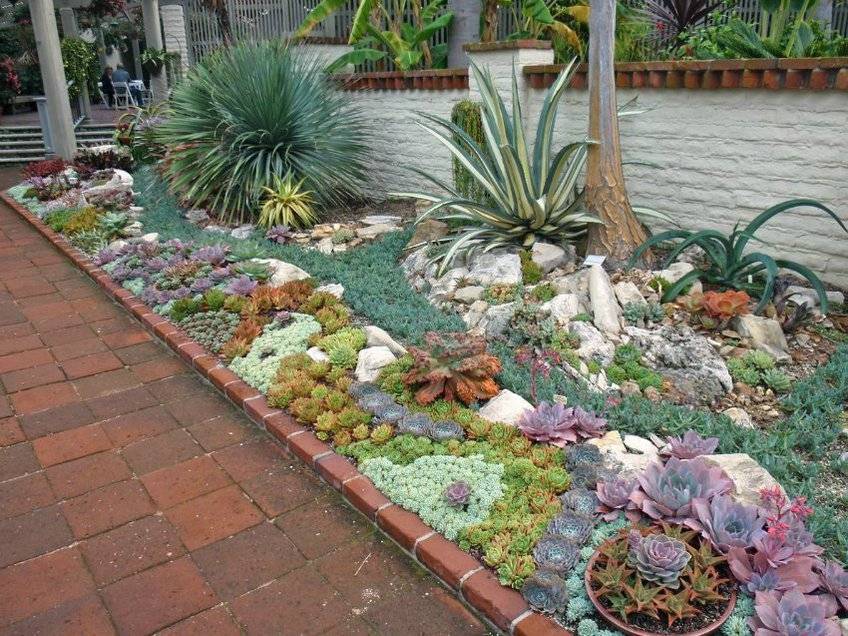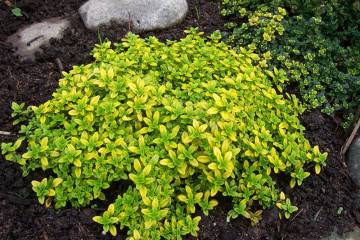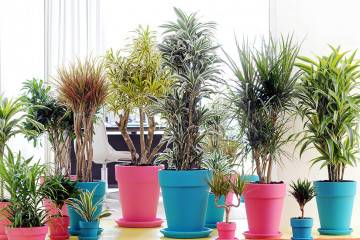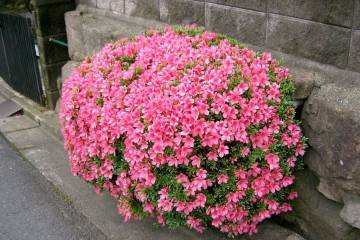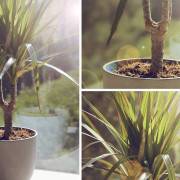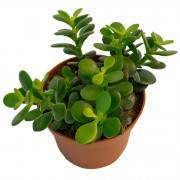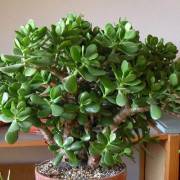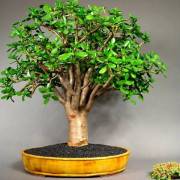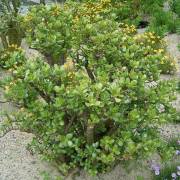Succulents street perennials - planting and care
Content:
Succulents are plants that are able to accumulate liquid in their own leaves and stems. Quite often, they can be found in the wild in arid places. They can do without watering for a long time, as they receive nutrients from the accumulated moisture. Succulents are a category of plants belonging to different families with different chemical composition and botanical description, as well as differing in appearance. They are united only by similar conditions of existence.
Succulents street perennials
Most gardeners prefer to plant perennial street succulents in their summer cottages or backyards, as they require minimal maintenance. There are many varieties of succulents that will adorn any territory. They are classified according to winter hardiness, drought resistance, light perception, etc.
Bacopa
Bacopa belongs to the genus Plantain. The birthplace of the flower, the second name of which is Sutera, is South Asia. The plant is creeping, ampelous. It can be used in landscape design as a ground cover plant, or it can be planted in pots, from which it will weave both down and up the support. Bacopa is known for its magnificent and long lasting flowering, which lasts almost 5 months. A variety of colors of flowers allows you to make a variety of different compositions, without using other plants.
There are 3 varieties of this succulent:
- Olympic Gold;
- Bluetopia;
- Scopia Double Blue.
Rejuvenated
Rejuvenated, or sedum, belongs to the Tolstyankov family. It is very popular among gardeners for its strong immunity and unpretentiousness to the conditions of detention. It is often called the "stone rose" for its similar arrangement of leaves. The leaves are oblong, deep green, with pointed tips, forming a dense rosette.
Delosperma
Delosperma is a succulent with a flowering duration of about 4 months. A low-growing groundcover that goes well with other succulents as well as with common herbaceous flowers. There are many types of delosperm, which differ in the color of the peduncles, the length and width of the leaves, and in height. The succulent leaves are fleshy, light green in color, with mild thorns over the entire surface. The plant prefers medium acidity soil.
Levisia
Levisia is a bushy succulent that came to the territory of Russia from North America. Belongs to the Portulacov family. The root system of the plant is vertical, powerful enough, develops in depth. The flowers are of various colors. Blooms for 5 months.
Levisia is divided into two types:
- shedding leaves;
- evergreen.
Plant varieties differ in appearance of leaves, color of peduncles, structure and size. In nature, you can find both a stunted Levisia and a plant whose height is about 50 cm.
Dorotheanthus
A low-growing plant, which is often compared to chamomile, due to the structure of the peduncle. Its peculiarity is that the petals of the flower are not smooth, like those of most succulents, but are covered with small pimples, resembling dew drops. The root system is vertical, branched. The most widespread variety in Russia is dorotheanthus daisy. This is a low-growing variety, reaching a height of no more than 10 cm. The leaves are smooth, pointed, dense.
Aptenia
This succulent is interesting in that its flowers bloom exactly at noon, guided by the position of the sun. A tall, creeping plant, reaching a length of about 1 m. This plant is demanding on air temperature, lighting and watering, therefore it is not as common among gardeners as, for example, sedum. It can grow both at home and outdoors.
Spurge myrtle
Medium-sized perennial with evergreen leaves. It develops very quickly, covering the soil with a dense layer of greenery. Drought-resistant. It is recommended to follow the boundaries allocated for the milkweed myrtle leaf, since it reproduces by self-seeding, and after 2 years it is from 1 sq. m. will reach an area of 20 sq.m. It is widely used in the design of personal plots and summer cottages. Possesses strong immunity.
Ragwort
This succulent belongs to the Astrov family. In the wild, you can find the bushy rosewort, in the form of a tree, in the form of a grass, etc. Outwardly, it resembles a watercress, but with more fleshy leaves and stem. In addition to its use for decorative purposes in the field, it is also successful in the manufacture of medicines in alternative and traditional medicine.
Groundcover or creeping succulents
Creeping succulents can grow in all conditions. This can be a vertical or horizontal flower bed, a wall of a house, a roof of a building, etc. Groundcover succulents cover the soil very densely, creating a carpet effect. Ground cover succulents protect the weed area, but it is recommended to fence off the area in which creeping and ground cover succulents will grow, as they very quickly take up vast areas of land. And since the layer of leaves is quite dense, something else simply cannot grow in this area, due to the lack of water and light.
Sedum (sedum)
Most often it can be found in meadows and mountain slopes. In landscape design, it is used to create rockeries and alpine slides. It is used for medicinal purposes for disinfection and treatment of scratches, wounds, as a general pain reliever. Most varieties are perennials, but there is also a two-year stonecrop. It blooms for 5 months, from early summer to mid-October. Finishes blooming with the appearance of the first frost.
Succulents in a flowerbed
In order not to get a messy planting in a flower bed, it should be carefully planned. Despite the fact that succulents on the street are combined with almost any flowers, you still need to draw a diagram, since even the height of planting is important in a flower bed. The rich green color of flowerbed succulents sets off any flowering herbaceous plants very favorably.
Succulents for an alpine slide
The rock garden, most often, is located in an open, sunny place.It is a competent pile of stones, from which water runs like waterfalls, and amazing, beautiful decorative flowers grow among the boulders.
Varieties of succulents used to decorate alpine slides:
- stonecrop;
- crumbs;
- rejuvenated;
- cacti;
- brittle stones.
How to create a garden of succulents with your own hands in the country
To make a mini garden of succulents, you need to choose a site where the flower bed will be located. For the outdoor version of the flower bed, it is recommended to choose slow-growing varieties of succulents. Given that these plants are not whimsical in maintenance and care, attention can be paid to them to a minimum, but regularly.
Also, before you arrange a kindergarten, you need to decide on the style.
Then everything is very simple. A drainage layer is poured at the bottom of a small hole, where the flower bed will be located. It can be expanded clay, broken brick, pebbles of the middle fraction, etc. The top is filled with soil or a special substrate, which can be purchased in specialized stores. Decor elements are installed: vases, houses, carts, bridges, benches, etc. Then succulents are planted according to the scheme drawn before the creation of the mini-garden.
Succulents in the garden: planting and care
Succulents in the country can be used to create rock gardens, rockeries, flower islands, etc. To decorate a garden or other outdoor areas with succulents, it is recommended to choose frost-resistant varieties.
Succulents outdoors: how they winter
It is advisable to cover succulents for the garden overwintering in the open field. Especially if the area of growth is the Moscow region. For example, in Siberia, using a layer of snow, a natural shelter for flowers is created, in other regions where severe frosts are observed, but without precipitation, perennials can be covered with film or agrofibre.
What soil to plant
Succulents prefer well-drained soil with a loose structure. Grow well in soils with weak acidity or neutral. And in acidic soil, they also will not die, but they may stop blooming or hurt more often. Also, in the soil with high acidity, garden succulents, which already grow very slowly, slow down their development even more.
If the soil is heavy, it is recommended to thin it with sand or pebbles. This will give the soil looseness and create a drainage layer. A common problem with succulents is rotting of the root system, so all conditions should be created so that water does not stagnate in the soil, even for a short period of time.
Succulents require minimal care. The optimal growth conditions are dry air and a sharp change in temperature. The closer the created conditions are to natural ones, the faster and better these plants will develop.
Fertilizer
There are special complex fertilizers designed specifically for succulents. They contain all the necessary micro and macro elements. You can feed the plants with organic matter.
Diseases and pests of succulents
As a rule, pests enter the succulent garden with a new purchased plant. All insects reproduce very quickly and spread over nearby flowers. Succulents should preferably be monitored for pests once every 14 days. As a preventive measure, once a month, you can treat the plants with a solution of laundry soap, which has proven itself well in the fight against all kinds of insects.
The immunity of these desert evergreen perennials is quite strong. But there are diseases to which they are prone. More often than others, succulents infect fungal diseases. This is due to the fact that during planting a small drainage layer was created and water stagnates in the root system of the plant, and this is an ideal microflora for the development of the fungus. In specialized stores, you can buy fungicides that fight the manifestations of fungal infections. In addition to chemicals, perennials are recommended to be transplanted.
Succulents are very unusual and exotic plants. They are able to decorate any site and add an exotic touch to any landscape design. With proper care and maintenance, even a novice gardener can handle the cultivation of these perennials.



